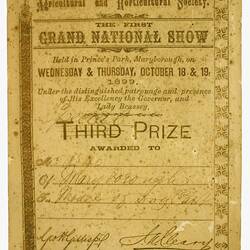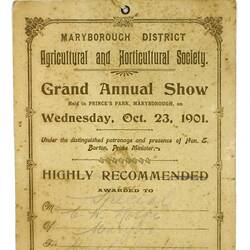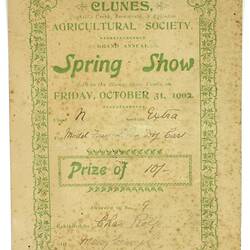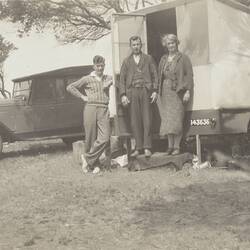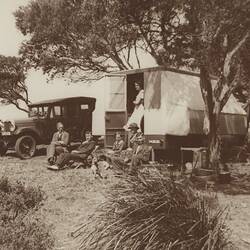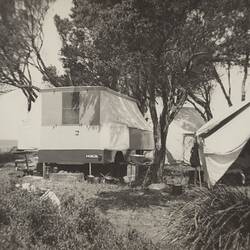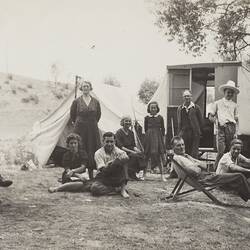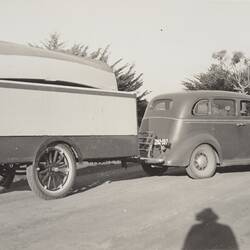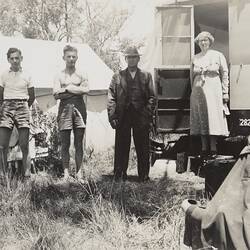Charles William Rolfe was the fifth of the eight children born to Francis Samuel and Phoebe Rolfe, and the third child to survive to adulthood. He was born at Maryborough, in central Victoria, on the 8th September 1878. [1,2] His father was the eldest son of Francis Rolfe senior and Alice (nee Webster) who had left England with their six children - Alice (aged 15), Francis (aged 14), Frederick (aged 12), Sophie (aged 9), Charles (aged 8) and Elizabeth (aged 2) - travelling assisted immigrants aboard the 707 ton sailing ship Helen, which departed Gravesend, London, on 3 July and landed at Portland, in south-west Victoria, on 12 November 1852. [3,4]
The difficult voyage had lasted over four months, during which time Black Fever broke out onboard, killing a number of passengers, including the 9 year-old Sophie Rolfe. The Helen, was one of 37 ships that arrived at Portland with assisted immigrants from Britain between 1851 and 1857, as local settlers sought to overcome the acute shortage of labourers and domestic workers created by the outbreak of the Victorian goldrushes. Most of the 260 assisted immigrants who arrived on the Helen were 'sponsored' by relatives or prospective employers to whom they were contracted to work for a period of up to two years. The Rolfe family were unusual as they were 'unsponsored' and were therefore not permitted to disembark from the ship until Francis senior had secured employment. He was soon offered a job as a stableman 'ostler' with the Henty Brothers and the family settled in Portland. Two years later they were living in Julia Street, Portland, when the youngest daughter, Elizabeth, also tragically died. [5]
In about 1857, the family moved to the Maryborough goldfields in central Victoria. There it appears that Francis Samuel Rolfe, the eldest son, worked initially as a miner, although with somewhat limited success. In April 1869 he was declared insolvent due to "looses in mining and want of remunerative employment", with liabilities totalling £43 19s, and assets worth just £4 12s 6d. [6]
In 1866, he had married Phoebe Meek, of Sydney, and the couple had eight children:
Alice Jane ROLFE - born Maryborough, 1868 - died Maryborough, 1873
Fanny ROLFE - born Maryborough, 1871 - died Maryborough, 1872, aged 6 months
John Francis ROLFE - born Maryborough, 1874 - died 1964
Emily ROLFE - born Maryborough, 1877 - died Albert Park, 1942
Charles William ROLFE - born Maryborough, 1878 - died Elsternwick, 1955
Walter Frederick ROLFE - born Maryborough, 1881 - died Maryborough, 1969
Daisy ROLFE - born Maryborough, 1883 - died Maryborough, 1907
Amy Alice ROLFE - born Maryborough, 1887 - died Parkville, 1958 [1,2]
Later Francis Samuel worked as a contractor on building and construction projects becoming a well-known and respected member of the Maryborough community. One of his most notable projects involved constructing sections of the stone-lined Maryborough main drain running 3.6 kilometres through the centre of the town. He appears to have become involved in the drain construction through his brother-in-law, Alexander Grey (the husband of his eldest sister Alice Jane), who won a £750 contract with the Maryborough Borough Council to build a section of the drain. On 25 July 1871, Grey assigned the uncompleted portion of the contract, worth £219 8s, to Francis Rolfe. [7,8]
Francis Samuel's second son, Charles William, grew up and was educated in Maryborough, later serving an apprenticeship with the local coachbuilding firm of Martin, Millgate & Cosstick. As part of his training Charles built a detailed scale model of a horse-drawn dog cart or buggy, which was later donated by the family to Museum Victoria. Between 1898 and 1902 he exhibited the model at several local agricultural shows, being awarded a number of prizes.
Charles Rolfe moved to Melbourne in the early 1900s and found work as a motor body trimmer with a firm in South Melbourne. Between 1911 and 1920, he is listed in the Sands & McDougall Directories at a series of residential addresses in North Melbourne, South Melbourne & St Kilda. [9] Around 1908 he met Mabel Tassell and they married in 1913. The couple's first child was a baby boy, who died after just 4 days. They subsequently had two further children - Mabel Dorie, born at South Melbourne on 27 Nov 1913, and Victor Charles, born at St Kilda on 30 Sept 1919. [1,2]
Mabel Tassell was born at Echuca on 2 July 1882. Her father Theodore Cook Tassell was born in 1848 and had worked in a senior position as manager of Cromer Station, near Germanton (now Holbrook), New South Wales. On 14 Nov 1892, he went missing while walking along Kennedy's Creek, a tributary of the Murray River, near Albury. His hat was found on the bank and a few days later his body was recovered from the flooded waters of the creek. A coronial inquest heard evidence that he probably committed suicide as it was reported that he had "for some time been in a most despondent condition" having had no regular employment for four years, however, an open verdict of "found drowned" was returned. [10] Mabel, together with her mother Janet and her sister Gertrude moved to Melbourne after his death.
In 1921, Charles & Mabel Rolfe built a Californian bungalow at 411 Kooyong Road, Elsternwick. Shortly afterwards Charles established his own business as a motor body builder in New Street, Elsternwick, where he was listed in the Sands & McDougall Directories from 1923-1925. In 1926, he moved the business to 91 Crown Street, Richmond, where he remained listed as Chas W. Rolfe, motor body manufacturer, until 1938. [9] A builder's plate from this period carries the words "C. W. ROLFE, The Expert Builder, 91 Crown Street, RICHMOND".
Aside from his business activities, Charles turned his skills to a variety of domestic projects, building a large timber sideboard for their Elsternwick home which is still owed by the family, and a wooden radiogram unit for the living room containing a gramophone and radio receiver. In the 1920s, he built a camper van trailer incorporating foldout beds and a pop-up roof, which was used for family holidays to places such as St Leonards, Taggerty, the Gippsland Lakes and the Barmah Forest. Charles purchased a DeSoto car that was used for towing the camper van and built a wooden boat that fitted neatly on top of the van. The camper van continued to be used by the family until the 1950s, when their son Victor had an accident while towing the rig and nearly destroyed it.
After Charles sold the Crown Street premises, he operated a panel beating workshop called Parnell Motors near his home in Elsternwick. Charles died on 16 July 1955 at the age of 77. He was cremated and a plaque with his ashes placed under a tree at the Springvale Cemetery. His wife, Mabel, continued living in the house at 411 Kooyong Road, Elsternwick until around 1970, when she moved to live with her daughter and son-in-law in Murrumbeena. She died at the age of 96, on 19 July 1977, and her ashes were placed beside those of Charles. [1]
References:
1. Biographical Notes on Charles William and Mabel Rolfe and Rolfe Family Tree, compiled by Colin Theobald, 2009.
2. Victorian Registry of Births, Deaths and Marriages.
3. 'Register of Assisted British Immigrants 1839-1871', book 6, pp.114-118, VPRS 14, Public Record Office, Victoria.
4. Syme, Marten A., Shipping Arrivals and Departures, Victorian Ports, Volume 2, 1846-1855, Roebuck Society, Melbourne, 1987.
5. Information from Mrs Norma Ahern, Adelaide, provided by Colin Theo bald.
6. The Argus (Melbourne), 19 Apr 1869, p.5 - 'New Insolvents'.
7. The Argus (Melbourne), 11 Nov 1902, p.6
8. The Argus (Melbourne), 1 Apr 1872, p.7, 'Harkness v. The Mayor, &c., of Maryborough' & 21 Aug 1871, p.5.
9. Sands & McDougall Directory of Victoria.
10. Sydney Morning Herald, 15 Nov 1892, p.5; 19 Nov 1892, p.10.
More Information
-
Keywords
-
Localities
Maryborough, Victoria, Australia, Richmond, Victoria, Australia
-
Authors
-
Article types

